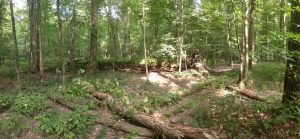When we first arrived at Johnson’s woods, I was not immediately impressed. I grew up surrounded by trees and wildlife, and have gone on many hikes in nature preserves through the Midwestern area, so seeing more woods was not initially new or exciting. As we really entered Johnson’s woods though, my feelings began to change.
Around the first corner of the path, there was an enormous fallen tree, which itself was not unique, or new. What was outstanding was the size of the tree, and the amount of life that had grown on that one decaying tree. It was covered in a blanket of deep green moss, with more spindly, lighter green plants emerging from that. It was also almost completely hollowed out at the end of it, with the inside a dark, mulchy brown, providing a home for more plants and some insects. The decaying tree was also providing a good home for fungi, with multiple mushrooms growing off of its bark. This large decaying tree being left to flourish and provide for new life was not something I commonly see on my hikes.
Another sharp contrast was the size of the trees in Johnson’s woods, some over 400 years old (Johnson’s Woods State Nature Preserve), older than the United States, or even the knowledge of gravity. The beech trees were some of the biggest I have ever seen, and the number of enormous old oak trees was amazing. Their towering height was also impressive, reaching up so high, I had to strain to see the tops, and identify the leaf shapes. I would have liked to get closer to just reach my arms around them and feel how big they really were, but in interest of preserving the rest of the forest, I resisted. In the forest, I was also able to see how when an old, canopy tree dies, and no longer shades the forest floor, it allows for other trees and plants to start growing. There was one spot where this was especially clear, where the trunk of a tree was still standing, but it was dead, and no longer had branches. I could tell that it must have been missing its branches for a few years, because while there were no other old, large trees close to it, there were some smaller younger trees beginning to fill in the space the dead tree left behind.
A final new experience of Johnson’s woods was the presence of the beech blight aphids, the fuzzy white bugs coating some of the branches of the beech trees. While observing these, I also noticed the ground below them also had a greyish coating over the leaf litter. After some research that led to the discovery of the names of the aphids, I learned that the grey dusty looking substance is actually mold that grows on the honeydew the aphids secrete after eating plant sap (Beech Blight Aphid). These were insects creating a phenomenon I had never seen before, that sparked my interest. So, while I arrived at Johnson’s Woods expecting just another hike through the forest, it gave me a whole new experience that I had never imagined.
Works Cited
Childs, Robert. “Beech Blight Aphid.” The Center for Agriculture, Food and the Environment.
UMassAmherst. October 2011. 11 September 2017.
Platt, Deb. “Johnsons Woods State Nature Preserve.” Trek Ohio. Trek Ohio. 24 March 2012.
11 September 2017.

Leave a Reply